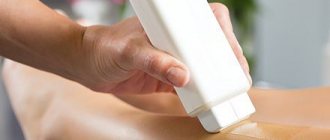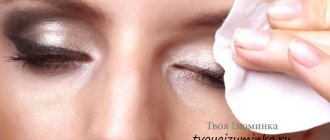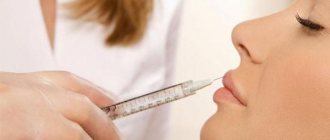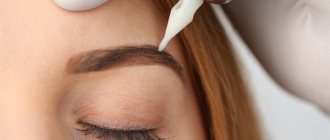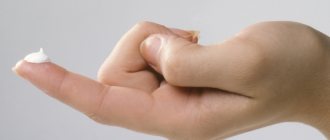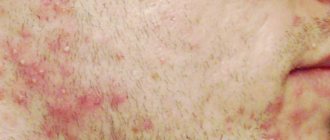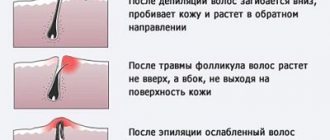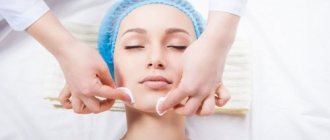It is believed that sugaring is the most painless procedure that best removes unwanted hair and after which ingrown hairs are less likely to form. But still, sometimes girls find rashes, peeling or severe irritation after sugaring. Why this happens and how to deal with it, we will tell you in this article.
Negative consequences of sugaring: the first signs of skin irritation and peeling
After sugaring, dehydration of the skin and, as a result, itching and keratinization of the upper layers of the epidermis are often observed. To prevent peeling, apply a moisturizer to the epilation site immediately after the procedure.
But irritation is most often noted after sugaring. The reasons for this may be different, but the general principle of the occurrence of a rash is as follows. The hair follicle is connected to the fat ducts, and the nerve ending is connected to them. This is why pain is felt when hair is removed.
But the worse thing is that fat gets into the place of the follicle, which provokes inflammation. It appears as red dots that usually disappear after a couple of hours, or at most a couple of days. If the inflammation does not go away within this period, you should consult a dermatologist.
If, after sugaring, the hair on the treated area begins to grow more actively, most likely, a hormonal imbalance has occurred in the body.
Consult an appropriate professional before performing the following procedure. In addition to redness after sugaring, subcutaneous ingrown hairs may appear over time. To prevent this from happening, between hair removal procedures it is necessary to treat the areas with special peelings.
Read how to deal with it and what to do if you have ingrown hairs after sugaring.
The main causes of irritation after sugaring
Why does skin irritation and peeling and even abscesses appear after sugaring? - unfortunately, this is a common occurrence. The reasons for this may be:
- increased sensitivity of the client's skin;
- violation of hygiene rules by both the cosmetologist and the client herself;
- non-compliance with the rules of the procedure with this sugar paste;
- Repeated application of paste to one area of skin.
If you did the procedure yourself, there are more reasons why irritation occurred. Among them, the most common is insufficient disinfection of the treatment site. Few people have enough experience to carry out this procedure correctly. But sometimes this happens when a session is conducted by an experienced specialist.
In this case, the problem may be hidden in the client’s sensitive skin or an allergic reaction to some components included in the sugar paste.
To avoid irritation and peeling of the skin in the future when performing the procedure yourself, the correct sugaring technique is necessary. Find out how to properly do sugar hair removal at home.
Possible consequences or side effects
Later I went to see masters of manual techniques and it seemed much more painful to me! If I had encountered a manual for the first time, I think the first time would have been the last.
I was pleased with the result. Hair does not grow back for a long time. They grow thin and soft, not bristly. And every time there are fewer and fewer of them. Bandage sugaring is a depilation procedure in which the master applies liquid heated sugar paste to the body with a spatula or roller in the direction of hair growth.
And then, placing a strip of special material on top, he pulls it along the hair growth. It is precisely because the paste is applied liquid and very warm that the procedure is especially gentle. The paste, since it is liquid, is applied gently, and not rubbed into the hair with a piece, as with a manual.
The hairs do not pull at the paste, there is no pain. The paste penetrates the pores, opens them and hairs are removed more gently and easily. Manual sugaring is a procedure in which the master takes a piece of hard sugar paste, kneads it and rubs it into the client’s hair against the growth direction. Then with his hands he pulls the same piece of pounded paste according to his height.
How to soothe your skin after sugaring
To prevent a rash that appears after sugaring, you can use special medications that relieve irritation, or use traditional methods that combat peeling and irritation.
Use of pharmaceutical products
During and after the procedure, it is recommended to use antiseptic ointments such as Miramistin, Solcoseryl, Actovegin, Chlorhexidine. They quickly stop the infection and help micro-wounds heal quickly. It is sometimes recommended to use 70% alcohol, hydrogen peroxide, or boric acid solution as an antiseptic. These products are excellent at fighting infections, but at the same time they dry out the skin. Therefore, in this case they must be abandoned.
If your skin peels off after sugaring, you can use a remedy for treating sunburn - Panthenol. It should be applied to irritated areas every three hours. If the irritation is minor, regular baby powder will help relieve it.
Traditional methods against irritation and peeling of the skin
You can use folk remedies to relieve irritation. For example, make a warm bath with a decoction or infusion of medicinal plants that relieve inflammation: celandine, string, calendula, chamomile.
You can simply lubricate the area with chamomile infusion. A tablespoon of herb is enough for a liter of boiling water. The mixture must be allowed to brew and cool. Then it can be used for wiping.
If redness appears after sugaring, you can lubricate it with homemade balm.
Take four tablespoons of any vegetable oil and mix them with a teaspoon of tea tree oil. Information .
You can make your own sugaring paste by mixing two cups of sugar, the juice of half a lemon and an eighth of a cup of water. To maintain viscosity, you can add a teaspoon of guarana gum. Lemon can be replaced with a solution of citric acid. A detailed recipe can be found in this article. Potato juice is known for its healing properties. It is enough to grate a few potatoes on a fine grater and apply the resulting pulp to the reddened areas for a couple of minutes. After this, you need to take a shower, and lubricate the treated areas with baby cream with chamomile or string extract.
If irritation does not go away for a long time after hair removal, you can apply a honey application to the reddened areas. After all, honey is an excellent antiseptic. Warm it slightly and spread a thin layer on the irritated area.
Skin care rules in the first days
To maintain the result and reduce the risk of complications in the first 1-3 days after hair removal, you must follow the rules of body care:
- For 1-2 days after the procedure, wash only with a shower with gentle (warm) water temperature. The first washing of the depilation area can be carried out no less than 2-3 hours after hair removal. If you have sensitive skin, it is better to avoid water treatments until the next day. You may need to shower frequently, as in the first days after hair removal you should avoid prolonged exposure to sweat on injured skin.
- Treat the depilation area with soothing agents (chamomile infusion, healing creams, etc.) and antiseptics (Chlorhexidine, Miramistin).
- Apply caring and anti-inflammatory agents at least 3 times a day. To speed up skin healing, you can smear the depilation area with special products with natural ingredients (cream, milk, cream with allantoin, shea butter, chamomile extract). Baby cream, aftershave lotion without alcohol, foam and cream with panthenol are also suitable for home care.
- Starting from day 2, lubricate the sugaring area daily with caring creams and hair growth inhibitors (blockers).
- 3-4 days after the procedure, immediately after inflammation and discomfort are relieved, it is recommended to polish the skin with a fine scrub, which will prevent ingrown hairs.
To get the desired effect, it is not necessary to use expensive professional care products. Soothing lotions and even hair growth inhibitors can be prepared at home from natural ingredients: herbal infusions, basic vegetable oils, etc. More complex ingredients for home remedies can be purchased in stores for fans of handmade cosmetics.
Prevention of skin irritation after sugaring: tips and recommendations
Unpleasant consequences after the procedure can be prevented. To do this, we recommend using the following tips.
Time for sugaring
Try to carry out the procedure from one in the afternoon to three. This is the period when the human body is least sensitive to pain. If the procedure is usually painful, you can take a painkiller 40 minutes before it begins. The most popular are “Pentalgin”, “Ketonal”, “Analgin”.
Preparing the skin for the procedure
To reduce pain, immediately before the procedure, the epilation site can be wiped with a piece of ice, increasing the effect of anesthesia. But if the main goal is to prevent irritation after sugaring, you need to take care of what to do a few days before hair removal. During this time, the skin must be constantly moisturized and softened. Before the procedure, you should take a bath, after which you should treat the skin with an antiseptic. It is advisable not to wipe it, but to allow all the moisture to be absorbed. Then the treated areas are sprinkled with talcum powder and the procedure begins. During the procedure, you must ensure that sweat does not protrude above the skin, constantly treating the area with talcum powder. Once in the wounds, it will cause irritation. It is recommended to treat the most delicate areas of the skin (for example, bikini area, armpits) with a soft scrub a few days before the procedure.
Watch a very useful video that simply and clearly explains how to care for your skin before and after sugaring to avoid ingrown hairs, redness and irritation.
Tips for performing sugaring
In order not to think later about how to get rid of irritation after depilation with wax or sugar, you need to fulfill simple requirements for the procedure. So, it should only be done with clean hands or wearing disposable medical gloves. The paste must first be kneaded well, warming it up to body temperature, but not allowing lumps to form. Then the clot is applied to an area sprinkled with talcum powder in advance, directing the movement against hair growth. Wait 10-15 seconds and with a sharp movement, tear off the paste in the direction of hair growth.
After completing the procedure on the intended area, treat it with an antiseptic and apply a moisturizer.
Do not use lotions or creams to avoid clogging the wounds and causing irritation. The next procedure can be carried out no earlier than 10 days later. Do not confuse sugaring and wax-sugar hair removal - these are two different procedures. The first is carried out simply with a paste, and in the second, after applying the product, a strip must be applied to the epilation site, which is then torn off. The products have different compositions. The sugar paste must be warmed to room temperature, and in the second case the product is applied hot.
Basic rules for preventing irritation and peeling
In order not to subsequently look for an answer to the question of how to quickly get rid of irritation after sugaring, you must adhere to the rules for preventing it. Before the procedure, treat the epilation area with an antibacterial agent, lightly steam it, then wipe it again with an antiseptic. This will prevent infection from getting into the wounds and subsequent inflammation.
You should not wear synthetic clothing after the procedure. Since it does not allow air to pass through well, the body sweats more intensely, sweat gets into the wounds and causes irritation. Clothing made from natural fabrics will reduce the likelihood that irritation will appear after sugaring, and you will not have to urgently decide what to do to remove it.
Every week, light peeling should be done on the treated area. This procedure prevents the development of ingrown hairs and abscesses. To be on the safe side, you can use medications that slow down hair growth.
Also, you should not visit a bathhouse, sauna, solarium, or swimming pool within 24 hours after the procedure. Otherwise, an infection may get into wounds that have not yet healed and cause inflammation. In summer, try to apply sunscreen for three weeks after the procedure.
Main indications and contraindications for laser hair removal
For me personally, this method feels much more painful than the bandage method. In it, the sugaring paste is heated to the consistency of liquid honey. Sugaring paste. Consists of glucose and fructose. It has a light pleasant smell of burnt sugar. Metal spatulas for bandage sugaring.
Thin and durable.
Allows you to apply a thin and even layer of paste. Wooden disposable spatulas for bandage sugaring. Non-woven strips for bandage sugaring. There is another type of bandage sugaring. When the paste is applied not with a spatula, but with a roller and a cartridge with sugar paste, which is preheated. It is similar to waxing, but hairs, unlike waxing, are removed according to their growth, and not against it.
Wax melter for cartridge and cartridge with sugar paste. Absolutely hypoallergenic. During waxing, hairs are removed against the direction of hair growth. This is much more traumatic for the skin and more painful, and also more conducive to ingrowth, since the direction of hair growth is disrupted. As a rule, having tried sugaring after waxing, clients never return to waxing.
Can you be allergic to sugaring?
Since the composition of the paste for this procedure varies, sometimes an allergy to sugaring may occur. This happens when the client has an intolerance to any of the components of the product. Therefore, if there is any suspicion of such reactions, a preliminary test should be carried out on a sensitive area of the skin.
The procedure is definitely contraindicated for people suffering from diabetes, no matter what stage of development the disease is at.
Sugaring is the most painless procedure for removing unwanted hair. But even after it, irritation and dry skin may occur. To reduce the likelihood of such unpleasant consequences, it is important to take preventive measures before and after the procedure, and most importantly, entrust it to a specialist.

